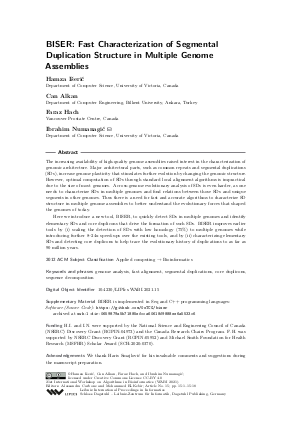@InProceedings{iseric_et_al:LIPIcs.WABI.2021.15,
author = {I\v{s}eri\'{c}, Hamza and Alkan, Can and Hach, Faraz and Numanagi\'{c}, Ibrahim},
title = {{BISER: Fast Characterization of Segmental Duplication Structure in Multiple Genome Assemblies}},
booktitle = {21st International Workshop on Algorithms in Bioinformatics (WABI 2021)},
pages = {15:1--15:18},
series = {Leibniz International Proceedings in Informatics (LIPIcs)},
ISBN = {978-3-95977-200-6},
ISSN = {1868-8969},
year = {2021},
volume = {201},
editor = {Carbone, Alessandra and El-Kebir, Mohammed},
publisher = {Schloss Dagstuhl -- Leibniz-Zentrum f{\"u}r Informatik},
address = {Dagstuhl, Germany},
URL = {https://drops.dagstuhl.de/entities/document/10.4230/LIPIcs.WABI.2021.15},
URN = {urn:nbn:de:0030-drops-143681},
doi = {10.4230/LIPIcs.WABI.2021.15},
annote = {Keywords: genome analysis, fast alignment, segmental duplications, core duplicons, sequence decomposition}
}

 Creative Commons Attribution 4.0 International license
Creative Commons Attribution 4.0 International license







